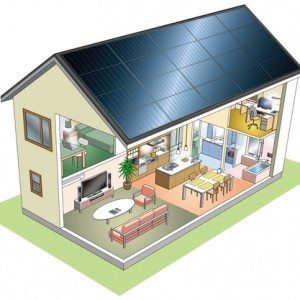 Going off the electrical grid can begin as an environmental or political ideal, but in practical terms, 2017 is the year to turn ideas into reality. For those brave pioneers who tried to free themselves from utility companies in years past, the available options today will seem like Utopia. While many details must be considered, your off-grid power plan needs two major components: the photovoltaic (PV) panels and the storage batteries.
Going off the electrical grid can begin as an environmental or political ideal, but in practical terms, 2017 is the year to turn ideas into reality. For those brave pioneers who tried to free themselves from utility companies in years past, the available options today will seem like Utopia. While many details must be considered, your off-grid power plan needs two major components: the photovoltaic (PV) panels and the storage batteries.
Plan
When deciding to make the leap to off-grid power, plan carefully. Calculate your power consumption needs, how many PV panels you will need to meet those needs and how many batteries (and of what type) you will require to store power for sunless days and overnight use. The first consideration is how long you expect batteries to sustain you and your family:
- Overnight and cloudy days?
- Through a snowstorm of three or four days?
A 24-volt battery bank could help you along through overnight or morning cloud cover, but if you are hoping to stretch batteries out to three or four days, you will need greater capacity.
You can find load calculators online. Take into account future growth in your family, so if now you have adorable toddlers, you can plan to have enough electricity to meet the needs of power-hungry teens.
The power consumption calculation guides you to battery selection. You have many choices in solar batteries these days, and prices are falling:
- Tesla Powerwall — using lithium-ion batteries for maximum efficiency
- Iron Edison — using nickel-iron batteries
- Adara — lithium-ion energy storage systems
Plan carefully, because batteries are still expensive, though environmentally far friendlier than using a gasoline-powered generator to keep the lights on when the sun is off duty.
Solar storage batteries work best when kept warm (80 ℉), so if you know you are going off-grid for your mountainside winter vacation home, expect to need more batteries than if you were planning an oceanfront installation for summers only.
PV Panels
PV panels can power your home’s entire ongoing needs and are the source for power storage sent to the backup batteries. In off-grid systems, the PV panels need to maximize energy collection, so you may find that rooftop panels are only a start. You may want to consider additional ground or pole mounts, or even panels that can rotate to capture as much sunlight through the day as possible.
Solar Charge Controller
Getting the power from the PV panels to the batteries requires a solar charge controller. The controller acts as a sort of one-way valve, preventing battery power from running out to the panels on cloudy days and keeping the batteries fully charged by the panels during sunny days.
A solar charge controller can either be a Maximum Power Point Tracking (MPPT) or Pulse Width Modulated (PWM) controller. The MPPT is superior, but more costly since it matches PV panel output to the battery bank’s capacity. A PWM controller is the more traditional, less expensive, solution.
Batteries
Though called “solar batteries,” the technology behind power storage is not exclusive to solar energy. All batteries store and deliver power as Direct Current (DC), rather than the Alternating Current (AC) our everyday appliances, computers, and devices demand. This means the flow is not directly from batteries into your home; you need an inverter, or possibly even two.
North American electrical current is 240 volts that are stepped down to 120 volts; some appliances (a stove, a clothes dryer) may use 240-volt AC, while everything else in your home requires 120-volt power. While some inverters can be ganged to provide 240 volts, you may find a simpler solution by creating two separate power feeds from the batteries.
Professional Partner
Before embarking on an exciting adventure in off-grid living, partner with seasoned solar professionals. Contact Golden Solar today to learn more about the many facets of off-grid solar power. You can avoid costly mistakes by tapping the knowledge and experience of the experts at Golden Solar.
The post
Off-Grid Freedom Is Yours appeared first on
Golden Solar.
 Elon Musk has always been considered a genius when it comes to envisioning new technology. The knock against Musk is that he has always had issues bringing that technology to life and making it practical for everyone. His company Tesla puts out electronic cars that are not affordable enough for the general public, and his space travel company Space X only caters to billionaires.
When Tesla announced a few years ago that it was going to change the residential housing market with its new solar roofing panels, there were a lot of skeptics. But it looks like Musk and Tesla may have a home run with this new roofing product, and Musk may finally be recognized as the innovator he has always tried to be.
Elon Musk has always been considered a genius when it comes to envisioning new technology. The knock against Musk is that he has always had issues bringing that technology to life and making it practical for everyone. His company Tesla puts out electronic cars that are not affordable enough for the general public, and his space travel company Space X only caters to billionaires.
When Tesla announced a few years ago that it was going to change the residential housing market with its new solar roofing panels, there were a lot of skeptics. But it looks like Musk and Tesla may have a home run with this new roofing product, and Musk may finally be recognized as the innovator he has always tried to be.
What Are Solar Roofing Panels?
Solar roofing panels are solar energy collection devices made of smoothed glass and shaped to look like standard roofing tiles. An entire solar roof from Tesla comes complete with a battery storage system and a power distribution element.
A solar roof is meant to replace the need to buy electricity from the local utility or at least cut down on the need for grid electricity significantly. Tesla is making a wide variety of tiles that mimic the current array of asphalt, wood and clay tiles to give consumers a common frame of reference. In a bold move, Tesla is offering a lifetime warranty on their solar roofs that is good for the life of your home – or infinity. Tesla does not state whether the warranty is transferable from one homeowner to the next.
Why Are People Talking About Solar Roofs?
If Tesla does allow the solar roof warranty to be transferred from one owner to the next, then that could be a significant selling point for any homeowner. Solar roofs, as with any other type of solar installation in a residential setting, are expected to raise property values considerably, and a transferable lifetime warranty only makes the deal sweeter.
A big reason why solar roofs are getting so much attention is because they are said to be, in the long run, more affordable than standard roofs. As an example, covering a 2,000-square-foot home in New York State with a solar roof would cost around $50,000. As with many solar products, solar roofs come with tax investment credits that make the product less expensive. In a span of 30 years (the course of a normal mortgage), that roof will generate approximately $64,000 in electricity.
That number works out to around $178 per month in electricity costs, which can seem high in any part of the country. But if you convert your entire home to electricity, from the furnace to the central air system, then you would recognize an incredible savings on your energy costs.
How Is The Solar Roof Changing The Residential Roofing Industry?
You would think that a roof with a lifetime warranty would be making residential roofing contractors nervous, but the solar roof still has some hurdles to get over before it becomes widely used. For one thing, the entire roof is not made of solar panels, which means that the consumer will have to pay to have expensive glass tiles installed to give their roof a consistent look.
A solar roof is the next step in alternative energy products, and the Tesla roof is only the first entry in that arena. The introduction of the Tesla solar roof is an indication to residential roofing contractors that the market is shifting, and contractors will need to do their homework on solar products if they want to stay competitive.
As with his other ventures, Musk has once again created a product that is only accessible to people with considerable financial means. While that is a nice market to work in, it does limit your possibilities for growth. This is especially true when your product carries a lifetime warranty.
The post
The Truth About Tesla’s Solar Roof appeared first on
Golden Solar.
 Going off the electrical grid can begin as an environmental or political ideal, but in practical terms, 2017 is the year to turn ideas into reality. For those brave pioneers who tried to free themselves from utility companies in years past, the available options today will seem like Utopia. While many details must be considered, your off-grid power plan needs two major components: the photovoltaic (PV) panels and the storage batteries.
Going off the electrical grid can begin as an environmental or political ideal, but in practical terms, 2017 is the year to turn ideas into reality. For those brave pioneers who tried to free themselves from utility companies in years past, the available options today will seem like Utopia. While many details must be considered, your off-grid power plan needs two major components: the photovoltaic (PV) panels and the storage batteries.

 Elon Musk has always been considered a genius when it comes to envisioning new technology. The knock against Musk is that he has always had issues bringing that technology to life and making it practical for everyone. His company Tesla puts out electronic cars that are not affordable enough for the general public, and his space travel company Space X only caters to billionaires.
Elon Musk has always been considered a genius when it comes to envisioning new technology. The knock against Musk is that he has always had issues bringing that technology to life and making it practical for everyone. His company Tesla puts out electronic cars that are not affordable enough for the general public, and his space travel company Space X only caters to billionaires.








